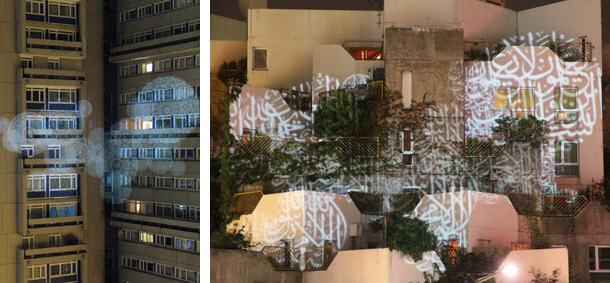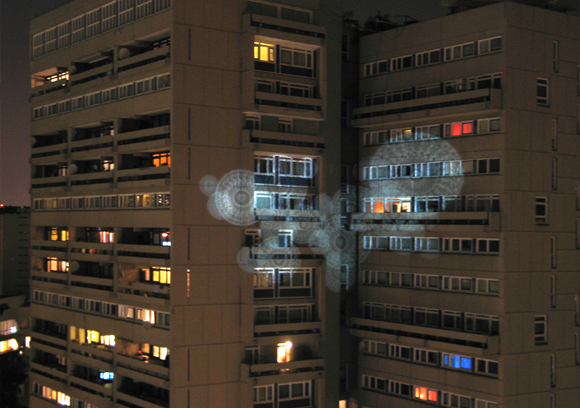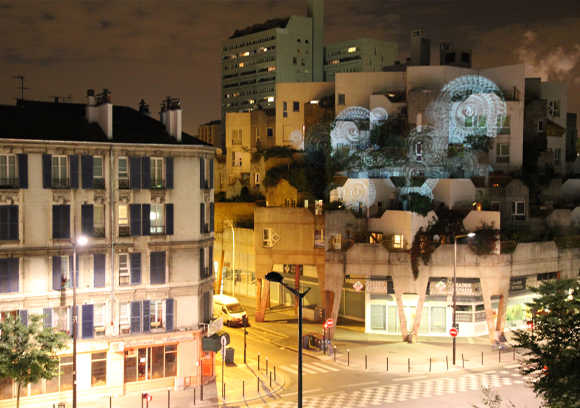| |
|
|
04.
| Ghosting |
| |


2009, video, France, 30 min, SD, 4/3, B&W, 5 min 26. Size may vary, video projection.
Exhibition view from Déreway to Basel, Public space project, 2011, Ivry-sur-Seine.
Courtesy of the artist.
''Ghosting is offered as an experiment at the crossroads of geometry, linguistics and contemporary art aiming to observe the interactions between different cultures and between the perceiving subjects and the world that surrounds them.''
Studio Fatmi, October 2011

Ghosting
Exhibition view from Déreway to Basel, Public space project, 2011, Ivry-sur-Seine.
Courtesy of the artist.

Ghosting
Exhibition view from Déreway to Basel, Public space project, 2011, Ivry-sur-Seine.
Courtesy of the artist.
|
|
|
|
|
|
Fresque lumineuse projetée sur des immeubles d'habitation d'une grande ville, Ghosting se compose d'une série de cercles calligraphiés s'entrecroisant, en rotation plus ou moins rapide dans les sens horaire et antihoraire.
L'installation interroge notre rapport au monde à partir de la mise en relation des images et de l'architecture, de l'art contemporain et de la religion. Ghosting est donc un dispositif aux inspirations multiples allant de la calligraphie arabe, à l'art contemporain en passant par la philosophie et la linguistique. Il rappelle les rotoreliefs à formes circulaires de Duchamp - machines à produire des illusions visuelles qui faisaient se rencontrer les techniques de l'art optique et celles du monde moderne industrialisé. Il renvoie au travaux de Wittgenstein autour des jeux de langage qui tentent de mettre en évidence la façon dont les significations naissent des usages et des contextes. Il interroge enfin notre rapport aux images en convoquant des courants philosophiques et des pratiques artistiques qui placent le rapport aux images au centre de leurs préoccupations. L'installation s'inspire notamment des notions de médiatisation et de reproduction en masse développées par Debord dans La Société du Spectacle.
Ghosting se propose comme une expérimentation au croisement de la géométrie, de la linguistique et de l'art contemporain dans le but d'observer les interactions entre différentes cultures ainsi qu'entre le sujet percevant et le monde qui l'entoure. L'installation étudie la manière dont les signes s'associent entre eux pour faire naître ou non des significations et peut se lire comme une métaphore du monde moderne : celle du mécanisme chaplinien et de la machine, avec ses rouages s'entraînant les uns les autres. En associant les éléments les plus divers, la machine de mounir fatmi participe à l'élaboration d'une esthétique de la profusion où les formes et les références culturelles et artistiques se multiplient. L'œuvre exerce une fascination et un effet hypnotique sur le spectateur. Elle tend également à l'égarer en mettant à mal ses repères visuels et ses facultés de perception et de reconnaissance des signes, traduisant ainsi une difficulté à voir et à penser le monde : les images s'assemblent et se mettent en mouvement jusqu'à devenir méconnaissables ou disparaître complètement, sans qu'il soit possible de décider si cette accumulation d'images empêche de penser correctement le phénomène observé ou si celle-ci prépare la libération du signe et son affranchissement par rapport aux pouvoirs de la société de l'image ou de la religion.
Ghosting fait finalement appel aux capacités d'observation et d'étonnement des spectateurs en les invitant à relever la tête et à porter un regard neuf sur ce qui les entoure, à développer une réflexion sur ce qui structure en profondeur nos sociétés et conditionne nos façons de vivre. L'œuvre incite à prendre conscience d'un univers urbain où tout fait signe et sollicite en permanence nos capacités cognitives et intellectuelles, dans le but de renouveler et de transformer notre rapport au monde.
Studio Fatmi, Octobre 2011.
|
|
A fresco of light projected onto apartment buildings in a big city, Ghosting comprises a series of intertwined calligraphed circles, rotating with varying speeds clockwise and counter-clockwise.
The installation questions our relation to the world by creating connections between images and architecture, contemporary art and religion. To do this, Ghosting draws from multiple inspirations, from Arab calligraphy to contemporary art, philosophy and linguistics. It is reminiscent of Duchamp’s circular rotoreliefs – machines that created visual illusions by combining the techniques of optical art and those of the modern industrialized world. It references Wittgenstein’s work on language-games that attempts to demonstrate how meaning stems from usage and context. Finally, it questions our relation to images by summoning philosophical currents and artistic practices that place the relation to images at the heart of their preoccupations. The installation is inspired in particular by the notions of media exposure and mass reproduction developed by Guy Debord in The Society of the Spectacle.
Ghosting is offered as an experiment at the crossroads of geometry, linguistics and contemporary art aiming to observe the interactions between different cultures and between the perceiving subjects and the world that surrounds them. The installation examines the way signs associate with one another to create meaning, or not; it can be interpreted as a metaphor of the modern world, like that of Chaplin’s machine, with its cogs that set each other in motion. By associating extremely diverse elements, Mounir Fatmi’s machine contributes to the elaboration of an esthetic of profusion where shapes and cultural and artistic references are rife. The work creates fascination and a hypnotic effect on viewers. It also tends to mislead them by meddling their visual points of reference and their faculties of perception and sign recognition, thus conveying the difficulty to perceive and conceive the world: the images are combined and move around until they are hardly recognizable or disappear completely, and it isn’t possible to decide whether that accumulation of images prevents the viewer from correctly analyzing the perceived phenomenon or whether it heralds the liberation of signs from the powers of society, images or religion.
Lastly, Ghosting calls upon the viewers’ capacity for observation and amazement by inviting them to look up and cast a fresh look on what surrounds them, to develop their reflection about the things that deeply structure our societies and condition our ways of life. The work encourages us to become aware of a urban environment where signs are everywhere and constantly appeal to our cognitive and intellectual capacities, in order to renew and transform our relation to the world.
Studio Fatmi, October 2011.
|
|
|
|